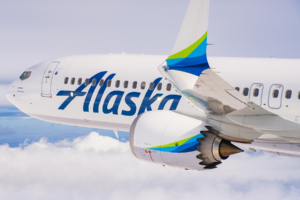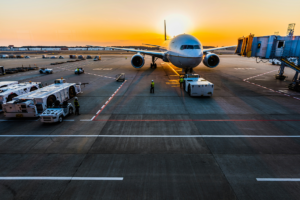G forces in a commercial aircraft?
#1
FlyerTalk Evangelist
Original Poster
Join Date: Mar 2004
Location: Newport Beach, California, USA
Posts: 36,062
G forces in a commercial aircraft?
I've always wondered . . . we all feel that initial thrust on take off that pushes us back into our seats and, also, occasionally, we'll feel positive and negative g-forces as planes bank, climb and descend (I'm not talking about turbulence -- just normal flight operations). Does anyone know how many g's a passenger will "pull" during typical flight conditions? I suspect it's not very much, but I've always been curious.
#3
Join Date: Sep 2004
Posts: 9,223
The g-force due to banking is only about 1.2 g at 30 degrees. That's hardly enough to notice. It does go up quite a bit at steeper angles, but then that would not be normal.
Interesting that the banking g-force is always perpendicular to the floor. So your drink shouldn't spill during banking.
Interesting that the banking g-force is always perpendicular to the floor. So your drink shouldn't spill during banking.
#4
FlyerTalk Evangelist
Original Poster
Join Date: Mar 2004
Location: Newport Beach, California, USA
Posts: 36,062
The g-force due to banking is only about 1.2 g at 30 degrees. That's hardly enough to notice. It does go up quite a bit at steeper angles, but then that would not be normal.
Interesting that the banking g-force is always perpendicular to the floor. So your drink shouldn't spill during banking.
Interesting that the banking g-force is always perpendicular to the floor. So your drink shouldn't spill during banking.
 ). It is nice that the laws of physics facilitate in-flight self-medication.
). It is nice that the laws of physics facilitate in-flight self-medication.
#5
Join Date: Sep 2004
Posts: 9,223
I just found a fairly definitive answer on a.net. Typcially the limit would be 0.75 to 1.25 g.
How Many G's Are Usually Pulled In A Civil Flight?
A g-force around 2 or 2.5 is pushing the limit of the airframe.
How Many G's Are Usually Pulled In A Civil Flight?
A g-force around 2 or 2.5 is pushing the limit of the airframe.
#6
Join Date: Aug 2005
Location: SNA Rwy 20L
Programs: QF Silver
Posts: 703
I believe this is correct for a coordinated turn (proper application of rudder input in relation to ailerons.) Unfortunately I've been on a ride or two when the pilot has allowed the aircraft to skid or slip in the turn resulting in the ruin of a new pair of suede shoes (not mentioning USair by name).
#7
Join Date: Sep 2004
Posts: 9,223
Airliners turn with aileron only. No rudder. Technically, this may be "uncoordinated," but it's done this way to keep the g-force perpendicular to the floor so drinks don't spill and PAX don't sway from side to side.
#8
Join Date: Apr 2007
Location: Australia
Posts: 6,352
Go to youtube and search for "stopped engine aerobatics" (I don't know how to link to it)
That Bob Hoover is amazing! Perfect 1g barrel roll.. while pouring iced tea into a glass.....in a twin job.. with the engines shut down.......

Had a ride in an A4T many years ago... pilot said we hit 6g....
That was MORE than enough for me.....
That Bob Hoover is amazing! Perfect 1g barrel roll.. while pouring iced tea into a glass.....in a twin job.. with the engines shut down.......


Had a ride in an A4T many years ago... pilot said we hit 6g....
That was MORE than enough for me.....
#9
Join Date: Jul 2007
Location: YVR
Programs: AC E
Posts: 142
I've had the rather interesting experiences of pulling 5Gs in a human centrifuge, and 2Gs (and 0!) in a parabolic flight, both within about a week of each other. I noticed that after those two experiences I became much more sensitive to the subtle changes in G forces that take place over the course of a normal flight, and my crappy estimating skills would peg the max I've felt in a commercial flight at about 1.25-1.4G
#13
Join Date: Feb 2002
Location: BNA
Programs: HH Gold. (Former) UA PP, DL PM, PC Plat
Posts: 8,356
The airplane turns because it is in a bank and a portion of the lift is in the horizontal direction. That horizontal component of lift is what causes the airplane to turn.
The ailerons are used to roll into, and out of, banks. Since the ailerons work by increasing the lift from one wing, and decreasing the lift from the other wing, the amount of drag produced by the two wings in not equal. (You produce more drag when you produce more lift) This has the tendency to yaw the aircraft in the direction opposite of the roll. Rudder is used to counter this adverse yaw and maintain coordinated flight.
The coordinated use of rudder and aileron is always the goal. With the relative slow roll rates used in airline flights the amount of adverse yaw is quite low and can be countered with very slight applications of rudder. Much of the required rudder application at slow roll rates comes from the yaw damper which is part of the autoflight system.
#14
Join Date: Sep 2004
Posts: 9,223
The horizontal component of lift would tend to make the plane slide. But the vertical tail fin, combined with the speed of the plane, blocks the sliding tendency and converts horizontal lift into a turn. The loss of vertical lift that occurs at the same time is compensated by using the elevator to pitch the plane up with an increase of lift. The pitch up is what leads to the increase in G-force; without the pitch up, the plane would spiral downward and you would feel only the normal 1 g of gravity.
Or at least that's how William Langewiesche explains it in his article called "The Turn" published by Atlantic Monthly and also in his book "Inside the Sky: A Meditation on Flight." I don't believe he mentions the rudder at all, but it's not intended to be a complete explanation of all the physics involved.
That's why I disregarded the rudder as being too minor to mention compared the other forces that are being generated. Perhaps Langewiesche meant to say "tail fin and rudder" but he didn't state it that way. That implies to me the rudder is hardly worth mentioning in a simplified explanation for the layman. But I could be wrong.
Or at least that's how William Langewiesche explains it in his article called "The Turn" published by Atlantic Monthly and also in his book "Inside the Sky: A Meditation on Flight." I don't believe he mentions the rudder at all, but it's not intended to be a complete explanation of all the physics involved.
That's why I disregarded the rudder as being too minor to mention compared the other forces that are being generated. Perhaps Langewiesche meant to say "tail fin and rudder" but he didn't state it that way. That implies to me the rudder is hardly worth mentioning in a simplified explanation for the layman. But I could be wrong.
#15
Join Date: Feb 2002
Location: BNA
Programs: HH Gold. (Former) UA PP, DL PM, PC Plat
Posts: 8,356
The rudder is used to counter adverse yaw which comes from the inequal drag from the wings due to the inequal lift produced while the airplane is rolling. Since the entire lift vector is not directly opposing weight, the total lift vector must be increased to maintain level flight. The larger lift vector produces the higher g-load.























